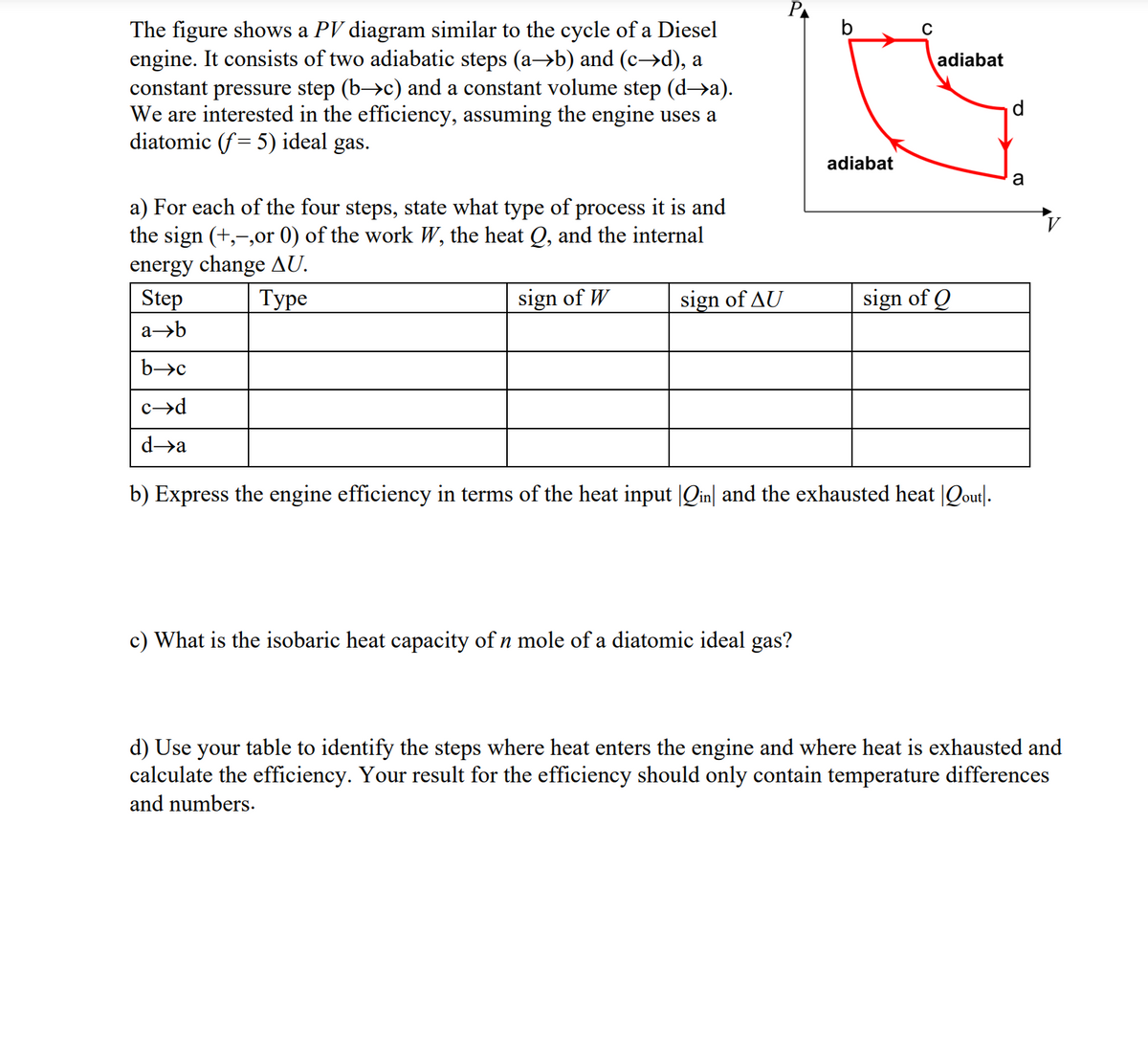The figure shows a PV diagram similar to the cycle of a Diesel engine. It consists of two adiabatic steps (a→b) and (c→d), a constant pressure step (b→c) and a constant volume step (d-a). We are interested in the efficiency, assuming the engine uses a diatomic (f = 5) ideal gas. a) For each of the four steps, state what type of process it is and the sign (+,-,or 0) of the work W, the heat Q, and the internal energy change AU. Type Step a-b sign of W sign of AU sign of Q b→c c→d d➜a b) Express the engine efficiency in terms of the heat input |Qin and the exhausted heat Qout. c) What is the isobaric heat capacity of n mole of a diatomic ideal gas? d) Use your table to identify the steps where heat enters the engine and where heat is exhausted and calculate the efficiency. Your result for the efficiency should only contain temperature differences and numbers. b adiabat C adiabat d a V
The figure shows a PV diagram similar to the cycle of a Diesel engine. It consists of two adiabatic steps (a→b) and (c→d), a constant pressure step (b→c) and a constant volume step (d-a). We are interested in the efficiency, assuming the engine uses a diatomic (f = 5) ideal gas. a) For each of the four steps, state what type of process it is and the sign (+,-,or 0) of the work W, the heat Q, and the internal energy change AU. Type Step a-b sign of W sign of AU sign of Q b→c c→d d➜a b) Express the engine efficiency in terms of the heat input |Qin and the exhausted heat Qout. c) What is the isobaric heat capacity of n mole of a diatomic ideal gas? d) Use your table to identify the steps where heat enters the engine and where heat is exhausted and calculate the efficiency. Your result for the efficiency should only contain temperature differences and numbers. b adiabat C adiabat d a V
Chapter6: Thermochemistry
Section: Chapter Questions
Problem 134IP: Nitromethane, CH3NO2, can be used as a fuel. When the liquid is burned, the (unbalanced) reaction is...
Related questions
Question
The last question

Transcribed Image Text:РА
The figure shows a PV diagram similar to the cycle of a Diesel
engine. It consists of two adiabatic steps (a→b) and (c→d), a
constant pressure step (b→c) and a constant volume step (d→a).
We are interested in the efficiency, assuming the engine uses a
diatomic (f = 5) ideal gas.
a) For each of the four steps, state what type of process it is and
the sign (+,-,or 0) of the work W, the heat Q, and the internal
energy change AU.
Туре
sign of W
Step
a→b
sign of AU
sign of Q
b→c
c→d
d→a
b) Express the engine efficiency in terms of the heat input |Qin and the exhausted heat |Qout.
c) What is the isobaric heat capacity of n mole of a diatomic ideal gas?
d) Use your table to identify the steps where heat enters the engine and where heat is exhausted and
calculate the efficiency. Your result for the efficiency should only contain temperature differences
and numbers.
adiabat
adiabat
d
a
Expert Solution
This question has been solved!
Explore an expertly crafted, step-by-step solution for a thorough understanding of key concepts.
Step by step
Solved in 3 steps

Knowledge Booster
Learn more about
Need a deep-dive on the concept behind this application? Look no further. Learn more about this topic, chemistry and related others by exploring similar questions and additional content below.Recommended textbooks for you


Chemistry
Chemistry
ISBN:
9781305957404
Author:
Steven S. Zumdahl, Susan A. Zumdahl, Donald J. DeCoste
Publisher:
Cengage Learning

Chemistry: The Molecular Science
Chemistry
ISBN:
9781285199047
Author:
John W. Moore, Conrad L. Stanitski
Publisher:
Cengage Learning


Chemistry
Chemistry
ISBN:
9781305957404
Author:
Steven S. Zumdahl, Susan A. Zumdahl, Donald J. DeCoste
Publisher:
Cengage Learning

Chemistry: The Molecular Science
Chemistry
ISBN:
9781285199047
Author:
John W. Moore, Conrad L. Stanitski
Publisher:
Cengage Learning

Introductory Chemistry: A Foundation
Chemistry
ISBN:
9781285199030
Author:
Steven S. Zumdahl, Donald J. DeCoste
Publisher:
Cengage Learning